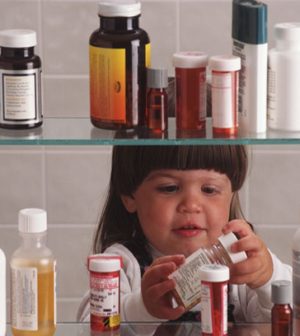- Skip Storing This Everyday Product in the Fridge Door
- Green Tea + B3 Pairing May Boost Brain Health
- Navigating Your Midlife Crisis: Embracing New Possibilities
- City Raccoons Showing Signs of Domestication
- Mapping the Exposome: Science Broadens Focus to Environmental Disease Triggers
- One Week Less on Social Media Linked to Better Mental Health
- Your Brain Changes in Stages as You Age, Study Finds
- Some Suicide Victims Show No Typical Warning Signs, Study Finds
- ByHeart Formula Faces Lawsuits After Babies Sickened With Botulism
- Switch to Vegan Diet Could Cut Your Greenhouse Gas Emissions in Half
Simple Drug Packaging Change Could Save Toddlers’ Lives

As America’s opioid crisis continues, too many toddlers are accidentally overdosing on narcotic medicines. But a new study suggests that better packaging might curb the problem.
Among kids under the age of 6, single-dose packaging prompted a 79 percent decrease in the number of unintentional exposures to a narcotic called buprenorphine. The medication is given alone or with the drug naloxone to help drug abusers beat their addiction.
“Unintentional pharmaceutical exposures in kids are a continuing problem, representing about half of calls to poison control centers,” said study author Dr. George Sam Wang. He is a pediatric emergency doctor at Children’s Hospital Colorado and medical toxicologist at Denver Health’s Rocky Mountain Poison and Drug Center.
But changing to individual blister packs has made an impact in preventing children from getting to the drugs, Wang said.
“We’ve seen a decrease in the number of children accidentally ingesting these medications, even as the use of the medications has gone up in adults,” Wang explained.
Between 2000 and 2015, poison control centers received more than 100,000 calls for opioid exposures in kids aged 5 and under. During that time, 68 deaths occurred, according to background information in the report.
For the new study, the researchers searched for accidental ingestions of buprenorphine-naloxone combination products based on calls to poison centers. The investigators looked at three time periods: before the introduction of single-dose packaging; during the time pharmaceutical companies were converting to single-dose packaging; and after single-dose packaging was widely available.
Now, over 80 percent of buprenorphine-naloxone products are distributed in single-dose packaging. Wang said the packaging is definitely a deterrent for kids, and is even a bit hard for adults to get into.
The findings showed that before single-dose packaging, for every 100,000 buprenorphine-naloxone prescriptions written, approximately 21 children under 6 years of age were accidentally exposed to the drug. During the transition period, that number dropped to about nine children per 100,000 prescriptions. After the single-dose packages became commonplace, just four youngsters were unintentionally exposed for every 100,000 prescriptions.
The researchers also noted that a previous study found a two-thirds reduction in the number of pediatric emergency visits due to accidental ingestions of buprenorphine-naloxone after single-dose packaging was introduced.
Dr. Pete Richel, chief of pediatrics at Northern Westchester Hospital in Mount Kisco, N.Y., said single-dose packaging is smart.
“It may cost more, but any methods or measures that will decrease the unintentional ingestion of any medication in children are imperative. A single-dose package provides an effective physical barrier,” Richel said.
Both experts believe single-dose packaging should be more widely used for other drugs, to protect children.
Wang said, “I think child-resistant packaging has gone back to the 1970s, and packaging single doses in blister packs should be considered for high-risk medications.”
However, both experts also said that resistant packaging is no substitute for parental vigilance.
“Parents need to be aware of the risk of having some of these medications in and around the home,” Wang stressed. “Equally as, if not more, important as packaging safety is keeping medications up and out of reach.”
Richel agreed that medications need to be out of reach. He also suggested using cabinet safety latches to keep youngsters out of cabinets. He added that anything that poses a significant risk to curious little ones (such as drugs or household cleaners) should be really out of reach — ideally at least 6 feet high.
The study was published online May 3 in Pediatrics.
More information
The U.S. Food and Drug Administration has 10 tips for preventing accidental overdose.
Source: HealthDay
Copyright © 2025 HealthDay. All rights reserved.










